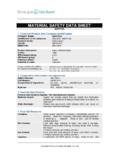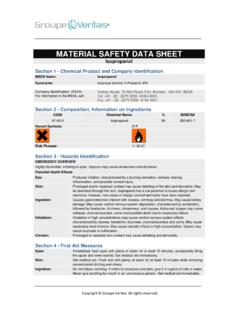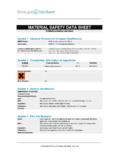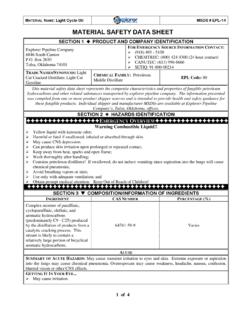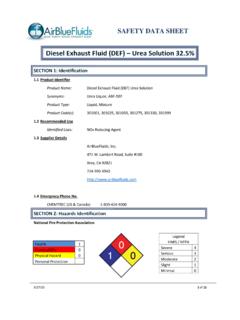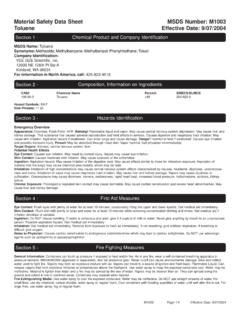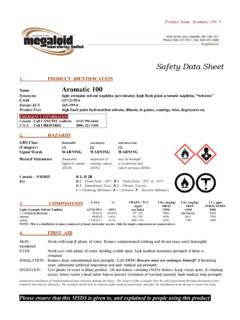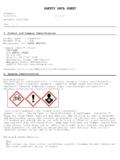Transcription of MATERIAL SAFETY DATA SHEET - hmlindia.com
1 Copyright Groupe Veritas. All rights reserved. MATERIAL SAFETY data SHEET Ethylene Dichloride MSDS Name: Ethylene Dichloride Synonyms: Dichloroethane ; EDC ; DCE Company Identification: (INDIA) Veritas House, 70 Mint Road, Fort, Mumbai - 400 001. INDIA For information in the INDIA, call: Tel: +91 - 22 - 2275 5555 / 6184 0000, Fax: +91 - 22 - 2275 5556 / 6184 0001 Section 2 - Composition, Information on IngredientsCAS# Chemical Name: % EINECS# 107-06-2 1,2-Dichloroethane +% 203-458-1 Hazard Symbols: T F Risk Phrases: 45 11 22 36/37/38 Section 3 - Hazards IdentificationEMERGENCY OVERVIEW Highly flammable.
2 Harmful if swallowed. Irritating to eyes, respiratory system and skin. May cause cancer. Potential Health Effects Eye: Causes severe eye irritation. Contact with liquid or vapor causes severe burns and possible irreversible eye damage. Causes redness and pain. Skin: Causes mild skin irritation. May be absorbed through the skin. Causes redness and pain. Ingestion: Harmful if swallowed. May cause central nervous system depression, kidney damage, and liver damage. May cause gastrointestinal irritation with nausea, vomiting and diarrhea. May cause effects similar to those for inhalation exposure.
3 Inhalation: Inhalation of high concentrations may cause central nervous system effects characterized by nausea, headache, dizziness, unconsciousness and coma. Causes respiratory tract irritation. May cause liver and kidney damage. Chronic: Prolonged or repeated skin contact may cause dermatitis. Prolonged or repeated eye contact may cause conjunctivitis. May cause liver and kidney damage. Section 4 - First Aid MeasuresEyes: Immediately flush eyes with plenty of water for at least 15 minutes, occasionally lifting the upper and lower eyelids.
4 Get medical aid immediately. Skin: Get medical aid. Flush skin with plenty of water for at least 15 minutes while removing contaminated clothing and shoes. Ingestion: If victim is conscious and alert, give 2-4 cupfuls of milk or water. Get medical aid immediately. Inhalation: Get medical aid immediately. Remove from exposure and move to fresh air immediately. If not breathing, give artificial respiration. If breathing is difficult, give oxygen. Notes to Physician: Copyright Groupe Veritas.
5 All rights reserved. Section 5 - Fire Fighting MeasuresGeneral Information: As in any fire, wear a self-contained breathing apparatus in pressure-demand, MSHA/NIOSH (approved or equivalent), and full protective gear. Vapors can travel to a source of ignition and flash back. Extinguishing Media: For small fires, use dry chemical, carbon dioxide, water spray or alcohol-resistant foam. Use water spray to cool fire-exposed containers. Water may be ineffective. Section 6 - Accidental Release MeasuresGeneral Information: Use proper personal protective equipment as indicated in Section 8.
6 Spills/Leaks: Absorb spill with inert MATERIAL ( vermiculite, sand or earth), then place in suitable container. Remove all sources of ignition. Use a spark-proof tool. Section 7 - Handling and StorageHandling: Wash thoroughly after handling. Remove contaminated clothing and wash before reuse. Use only in a well-ventilated area. Use with adequate ventilation. Do not get on skin and clothing. Keep container tightly closed. Keep away from heat, sparks and flame. Do not ingest or inhale. Use only in a chemical fume hood. Storage: Keep away from heat, sparks, and flame.
7 Store in a tightly closed container. Keep under a nitrogen blanket. Keep from contact with oxidizing materials. Store in a cool, dry, well-ventilated area away from incompatible substances. Flammables-area. Section 8 - Exposure Controls, Personal ProtectionEngineering Controls: Local exhaust ventilation may be necessary to control any air contaminants to within their TLVs during the use of this product. Use adequate general or local exhaust ventilation to keep airborne concentrations below the permissible exposure limits. Exposure Limits CAS# 107-06-2: United Kingdom, WEL - TWA: 5 ppm TWA; 21 mg/m3 TWA United Kingdom, WEL - STEL: 15 ppm STEL; 63 mg/m3 STEL United States OSHA: 50 ppm TWA; 100 ppm Ceiling Belgium - TWA: 10 ppm VLE; 41 mg/m3 VLE France - VME: 10 ppm VME; 40 mg/m3 VME Germany: 5 ppm TWA; 20 mg/m3 TWA Japan: 10 ppm OEL; 40 mg/m3 OEL Malaysia: 10 ppm TWA; 40 mg/m3 TWA Netherlands: ppm MAC; 7 mg/m3 MAC Russia: 10 mg/m3 TWA (vapour) Spain: 5 ppm VLA-ED.
8 20 mg/m3 VLA-ED Personal Protective EquipmentEyes: Wear chemical splash goggles. Skin: Wear appropriate protective gloves to prevent skin exposure. Clothing: Wear appropriate protective clothing to prevent skin exposure. Respirators: Follow the OSHA respirator regulations found in 29 CFR or European Standard EN 149. Use a NIOSH/MSHA or European Standard EN 149 approved respirator if exposure limits are exceeded or if irritation or other symptoms are experienced. Copyright Groupe Veritas. All rights reserved. Section 9 - Physical and Chemical PropertiesPhysical State: Clear liquid Color: colorless Odor: chloroform-like pH: Not available Vapor Pressure: 65mmHg @29 deg C Viscosity: mPas @20 deg C Boiling Point: 81 - 85 deg C @760mmHg Freezing/Melting Point: -35 deg C ( F) Autoignition Temperature: 440 deg C ( deg F) Flash Point: 13 deg C ( deg F) Explosion Limits: Lower: Vol % Explosion Limits: Upper: Vol % Decomposition Temperature: Not available Solubility in water: g/l (20 C) Specific Gravity/Density: Molecular Formula.
9 C2H4Cl2 Molecular Weight: Section 10 - Stability and ReactivityChemical Stability: Stable under normal temperatures and pressures. Conditions to Avoid: Incompatible materials, light, ignition sources, excess heat, electrical sparks. Incompatibilities with Other Materials Strong oxidizing agents, reducing agents, bases, alkali metals, aluminum, liquid ammonia, nitric acid, organic peroxides. Hazardous Decomposition Products Hydrogen chloride, carbon monoxide, carbon dioxide. Hazardous Polymerization Will not occur. Section 11 - Toxicological InformationRTECS#: CAS# 107-06-2: KI0525000 LD50/LC50: RTECS: CAS# 107-06-2: Draize test, rabbit, eye: 63 mg Severe; Draize test, rabbit, eye: 500 mg/24H Mild; Draize test, rabbit, skin: 500 mg/24H Mild; Inhalation, mouse: LC50 = 1060 mg/m3/6H; Inhalation, rat: LC50 = 1000 ppm/7H; Inhalation, rat: LC50 = 5100 mg/m3/6H; Oral, mouse: LD50 = 413 mg/kg; Oral, mouse: LD50 = 413 mg/kg; Oral, rabbit: LD50 = 860 mg/kg; Oral, rabbit: LD50 = mL/kg; Oral, rat: LD50 = 500 mg/kg; Skin, rabbit: LD50 = 2800 mg/kg.
10 Other: Skin, rabbit: 625 mg mild Carcinogenicity: 1,2-Dichloroethane - California: carcinogen, initial date 10/1/87 NTP: Suspect carcinogen IARC: Group 2B carcinogen Other: See actual entry in RTECS for complete information. Copyright Groupe Veritas. All rights reserved. Section 12 - Ecological InformationEcotoxicity: Not available Section 13 - Disposal ConsiderationsDispose of in a manner consistent with federal, state, and local regulations. Section 14 - Transport Information IATA IMO RID/ADR Shipping Name: ETHYLENE DICHLORIDE ETHYLENE DICHLORIDE ETHYLENE DICHLORIDE Hazard Class: 3 ( ) 3 ( ) 3 ( ) UN Number: 1184 1184 1184 Packing Group: II II II USA RQ: CAS# 107-06-2: 100 lb final RQ; kg final RQ Section 15 - Regulatory Information European/International Regulations European Labeling in Accordance with EC Directives Hazard Symbols: T F Risk Phrases: R 45 May cause cancer.


